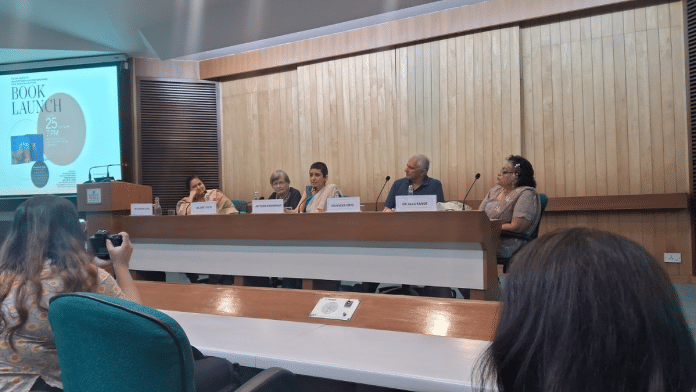New Delhi: Ladakh has a reputation for its high-altitude motorable passes, picturesque valleys, and stunning night skies that feature on top of a traveller’s bucket list. But embedded in these lofty mountains is an art form seldom talked about. Petroglyphs—the prehistoric rock carvings—are cultural time capsules and reflect the social and religious influences that neighbouring regions have had on Ladakh over centuries.
From remote mountainous areas to river banks, petroglyph sites are scattered across the Union Territory, but they rarely make it to conversations about Ladakh. Ahtushi Deshpande, a photographer, travel journalist and author, hopes this will change with the launch of her book Speaking Stones: Rock Art of Ladakh, a collection of 260 photographs of stone-carved art from Ladakh’s expansive open-air galleries.
“Being a travel journalist, my objective was to bring it (petroglyphs) out of academia and present it to the public in a way they could comprehend its importance as well as connect with it,” said Deshpande at the Gulmohar Hall, India Habitat Centre, Delhi.
The author was among the first to arrive at the event, making sure she greeted everyone who had come to appreciate her work, which, she said, was the result of “13 years of labour and love”.
Soon, the audience, including photographers, trekkers, dancers, and some Ladakhi students, began trickling into the hall, which got nearly packed.
On the panel were Janet Rizvi, historian and author specialising in Ladakh and the chief guest for the book launch, and Alka Pande, art historian and museum curator.
The audience listened keenly to Deshpande as she began showcasing her work through a slideshow and familiarised the gathering with different rock art forms around the world and their cultural and historical significance.
Also read: ‘Mango has to survive’— this juicy Delhi book launch was all about India’s favourite fruit
A deep connect
Deshpande described Ladakh as a geological wonderland and explained how its dry and cold climate slowed down the degradation of petroglyphs. The photos, displayed on two screens on either side of the panel, featured intriguing rock art — a giant figure surrounded by smaller carvings, a mother with a protective arm around her child, masked faces, ibexes, and even tigers, which are usually not associated with Ladakh. Each one of them was unique and carried the ancestral heritage of Ladakh with layers of expressions and meanings.
It was one such rock carving in Ladakh that left Deshpande spellbound when she visited her first petroglyph site back in 2011. It was a eureka moment for her that prompted her to embark on a journey and produce the book.
“It made a deep connect, one which I can neither fathom nor explain but I knew I had to document this work and bring out the flair. Besides, it was an aspect of Ladakh completely unheard of and ignored at the time and no one in the mainstream in India had done any work on it,” Deshpande told ThePrint.
The author said she also wanted to provide an armchair travel guide to the petroglyph sites located in deep ravines and regions that are hard to access due to treacherous terrain.
For Rizvi, Deshpande’s role has been to “build on the work of researchers who have gone before her, trek sites all over Ladakh, and exercise her quite remarkable talent as a photographer in order to bring this amazing art before a wider public”.
Rizvi said the rock carvings suggest that the communities who made them had a strong creative impulse since they used the “unforgiving medium of rocks” to express themselves.
Also read: Orientalist artists romanticised Colonial-era India. Pilgrims disappeared from paintings
Saving the art form
Putting Deshpande’s work in the global context, Pande juxtaposed petroglyphs captured by the author in Ladakh with rock art found in different parts of the world such as Scotland, Norway, Spain, and the Amazon rainforest.
“Petroglyphs are found in almost all ancient civilisations of the world, and you will find that there is a universal language to them,” said Pande.
Using a laser pointer, she highlighted the similarities and the subtle differences in rock art seen across the globe, wowing the audience that remained glued to the screens.
Notably, some of the author’s work cannot be replicated as they don’t exist anymore and were lost to road widening projects and other construction work.
Hoping that the author’s work will make a difference, Jigmet Dolker, a Ladakhi student studying in Delhi, said that not just residents of metro cities but even most of the Ladakhi people are not aware of petroglyphs. She added that local people don’t consider them important enough to be conserved unless they represent Buddhist culture and deities. “Then they keep it (rock art) above themselves”.
Recognition could be an effective way to save the ancient rock art of Ladakh, but, at the same time, it could also hamper conservation efforts.
“The only looming threat in popularising it is the inscribing of modern graffiti by people scribbling names, etc. If we are to truly protect them for the future, there is no other way but to highlight them. I do feel that protection can only be achieved through conservation,” asserted Deshpande.
(Edited by Humra Laeeq)






